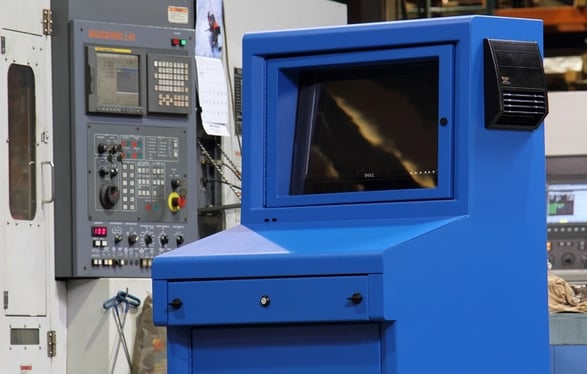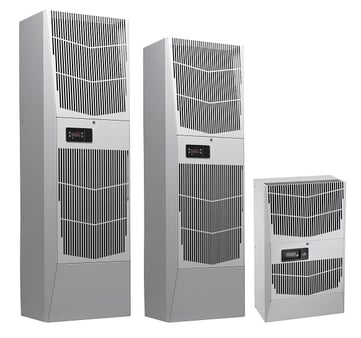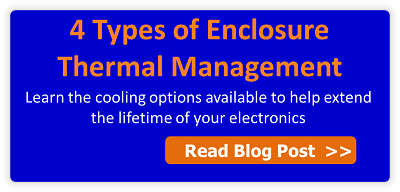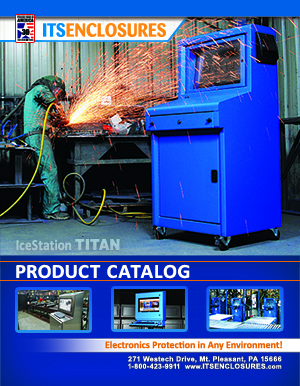What toll will heat and humidity take on electronics in manufacturing environments?
When choosing a computer enclosure, it is always a good rule of thumb to determine the necessary thermal management. An enclosure that has an internal temperature of over 95°F generally calls for a cooling system that is more powerful than a filtered fan system. Ambient air flow, through a filtered fan system, will not provide enough cooling power to regulate temperatures inside the computer enclosure within the recommended operating temperatures.
Appropriate cooling is absolutely necessary to keep electronics running smoothly and efficiently. Joe Primeau, from Acromag, describes in his blog, “Thermal Management for the Small Box,” how vents and fans can sometimes be ineffective, “Although forced convection can cool more effectively than vents alone, they share similar problems. Both methods allow moisture, dust and contaminants to enter the enclosure, threatening the electronics. Concern also has to be given to what happens if/when the fan fails or becomes blocked; this could quickly lead to overheating and possibly failure of the electronics.” When it comes to essential electronics, failure is not an option!
Technical specifications, published on a manufacturer website, will indicate the appropriate cooling and/or heating necessary to operate electronics within the suggested temperatures and humidity levels. It is no surprise that humidity can be extremely harmful to electronics. According to the article “Humidity, Its Effect on Electronic Industry and Solutions” by Uday Chakravarty, Sales Manager-International at Arctic India Sales, humidity is the root of many evils, “Humidity is a constant threat to production efficiency and product quality… Rust, mold, mildew, rot, decay, warping, stretching, lumping, caking, agglomeration and decomposition are all common enough problems encountered in our daily life. It is interesting to note that the root cause of all these problems and many more, is the presence of moisture or humidity in the air.”
 If deploying electronics in a particularly humid environment, advanced systems such as a heat exchanger or air conditioner are smart cooling methods. Combined with a NEMA 12, NEMA 4, or NEMA 4X sealed enclosure, a closed loop cooling system will ensure humidity is kept outside of the cabinet and unable to harm sensitive (and often expensive) electronics. Briskair, sums up the importance of air conditioners quite simply, “Regardless of the type of air conditioner or the job you perform, in general air conditioning offers a number of benefits… Extreme conditions such as heat and humidity can impact [electronics] overall physical intellectual activity, making even the simplest of tasks an absolute chore. Having a proper air conditioning system in place helps reduce heat and humidity, thus reducing the impact on our ability to perform and complete work tasks.”
If deploying electronics in a particularly humid environment, advanced systems such as a heat exchanger or air conditioner are smart cooling methods. Combined with a NEMA 12, NEMA 4, or NEMA 4X sealed enclosure, a closed loop cooling system will ensure humidity is kept outside of the cabinet and unable to harm sensitive (and often expensive) electronics. Briskair, sums up the importance of air conditioners quite simply, “Regardless of the type of air conditioner or the job you perform, in general air conditioning offers a number of benefits… Extreme conditions such as heat and humidity can impact [electronics] overall physical intellectual activity, making even the simplest of tasks an absolute chore. Having a proper air conditioning system in place helps reduce heat and humidity, thus reducing the impact on our ability to perform and complete work tasks.”
The key to effectively managing heat in manufacturing environments is to determine the right thermal management before deploying the computer enclosure.
The three most vital things that you need to know: enclosure size (height x width x depth), ambient temperatures (highest and lowest expected temperature outside enclosure; highest and lowest temperature allowed inside enclosure), and the total equipment load in watts (sum of all heat producing equipment), which is typically available on the published manufacturers’ specs online. Enclosure construction (steel vs. aluminum vs. stainless steel) can also affect the necessary thermal management.
This simple to use formula is valuable for picking the right thermal management:
(watts x 3.413) + (1.25 x area in square feet x ∆T temperature difference in degrees F) = BTU/hr.
Watts = The total heat load inside the enclosure (the sum of all heat-producing equipment)
Area = Total exposed surface area of the enclosure expressed in square feet
∆T = The difference in temperature between the maximum expected degrees F temperature outside the enclosure and the maximum degrees F temperature allowed inside the enclosure
Always put in the time and effort to find the best thermal management that will reduce the harmful effects of heat and humidity. If the correct thermal management is not chosen in the beginning, money and productivity will be lost with every minute of downtime. Electronics’ and/or thermal management failures will end up costing more money in the long run. Choosing wisely up front will keep overhead down considerably!
For more information:
MANAGING HEAT LOAD FOR COMPUTER ENCLOSURES
3 PROBLEMS THE RIGHT THERMAL MANAGEMENT ELIMINATES FOR PC ENCLOSURES
DEPLOYING COMPUTER ENCLOSURES IN HUMID ENVIRONMENTS
HAVE QUESTIONS? LET US KNOW HOW WE CAN BEST ASSIST YOU! CONTACT AN 'ITSENCLOSURES EXPERT' AT 1-800-423-9911 -OR- SEND US AN EMAIL: INFO@ITSENCLOSURES.COM



